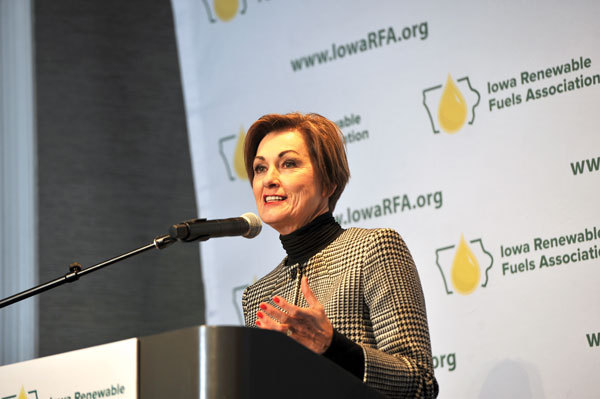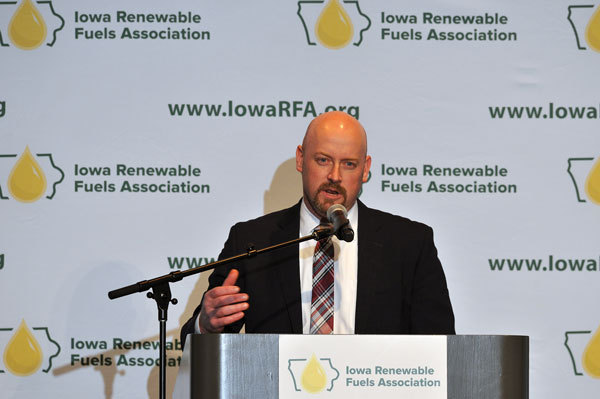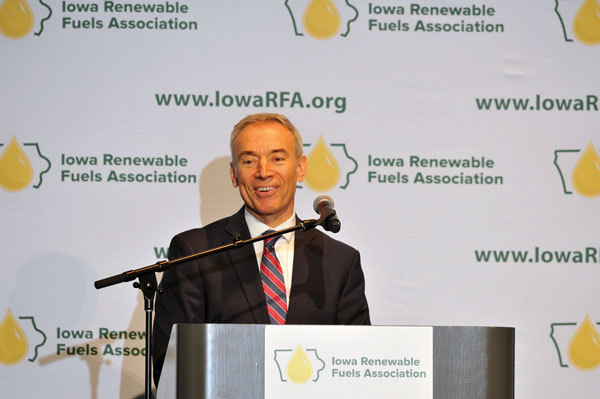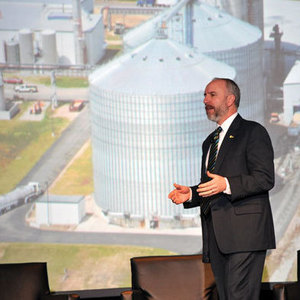Policy, Predictions and Positivity






PHOTOS: IOWA RENEWABLE FUELS ASSOCIATION
March 25, 2020
BY Matt Thompson
During the third week of January, the ethanol industry celebrated some uplifting news. In addition to the U.S. Senate’s approval of the U.S.-Mexico-Canada trade agreement, Phase 1 of a trade deal with China was approved by both countries.
Both of those developments happened during the week of the 2020 Iowa Renewable Fuels Summit in Altoona, Iowa, so there was much to discuss as the industry reflected on 2019 and looked forward to 2020.
The Road Ahead
Monte Shaw, IRFA executive director, began the one-day summit Jan. 16 by reflecting on 2019 and offering optimism for the coming year. He acknowledged the difficulties faced by the ethanol industry in 2019, from poor corn growing conditions across the Midwest, to demand destruction brought on by the trade war with China and the U.S. EPA’s issuance of small refinery exemptions. “2019 was the first year that Iowa ethanol production was lower than the year before,” Shaw said.
But, he reminded attendees, there were reasons to celebrate in 2019. “We’ve been so focused on what we didn’t get that we’ve neglected to appreciate what we did,” Shaw said, as he highlighted efforts to increase trade opportunities with Mexico and the extension of the Reid vapor pressure waiver to E15, which is often marketed as Unleaded88. “Whether Big Oil likes it or not, we’re well on our way to start making Unleaded88 the new normal for fuel in the U.S.,” Shaw said.
And looking forward, Shaw said building a working relationship with EPA will be instrumental for the ethanol industry. “Speaking for myself, I am ready to try,” Shaw told his audience. “I want to work with the EPA to take small steps and large steps to rebuild some of that trust.”
Cooper’s Keynote
Geoff Cooper, president and CEO of the Renewable Fuels Association, delivered the summit’s keynote address, and echoed much of Shaw’s frustration and optimism. “There was a silver lining to 2019, and I could say without equivocation or hyperbole that the biofuels industry held together and circled the wagons more tightly in 2019 than we’ve ever done before,” Cooper said. He concluded his address by offering four predictions for the ethanol industry’s next 10 years.
He first predicted that the Renewable Fuel Standard will continue to be a contentious program and battles over the legislation will become more intense. “This may be the safest prediction I’ve ever made,” Cooper conceded. “We know our opponents will continue to attack the RFS using every tactic available and of course, we’ll have a counterpunch ready for every one of their jabs,” Cooper said. “They’ll continue to lobby congress and the administration to undermine the program. They’ll fund junk science and run negative ads. They’ll continue to look for clever loopholes for avoiding compliance. They’ll spread myths and misinformation about ethanol, the RFS and (renewable identification numbers). They will continue to sue EPA at every turn, and in fact, the oil industry has already announced its intentions to take EPA to court over the just-finalized 2020 RVO rule.”
Cooper also predicted the expansion of a low-carbon fuel standard outside of California in the coming years. “States across the country are moving ahead with their own programs and their own plans and policies aimed at decarbonization,” he said. “And because the transportation sector has emerged as the single largest source of greenhouse gas emissions, there’s a lot of focus on fuels and vehicles and one very promising policy that they look at as a way to contain emissions from transportation is a low-carbon fuel standard.”
Cooper’s third prediction was tied to ethanol exports, as he said RFA expects a resolution to the trade war and new emerging export markets for U.S. ethanol to help the industry grow. “As 2020 begins, however, there are signs of hope that things will soon improve in the export market,” Cooper said. “We learned just yesterday … that fuel ethanol is indeed included in the Phase 1 trade deal with China and that country remains committed to using ethanol as a way to address air quality concerns.”
Advertisement
Cooper’s final prediction was that E15 would supplant E10 as the standard fuel at U.S. gas stations. He said EPA’s approval of year-round E15 sales was important, but further work is needed to drive adoption among more retail stations. “If EPA actually finally enforces a 15 billion-gallon RFS in 2020 and beyond, and the RIN markets begin to show signs of life, that could create a spark,” Cooper said. “Approval of E15 in California could turn that spark into a flame. More LCFS programs could turn that flame into a fire and retooling of gasoline BOBs [blendstocks for oxygenate blending] for 15 percent ethanol, or a requirement for higher minimum octane ratings, could turn that fire into a blaze. And by 2030 we could be in a situation where E15 is as ubiquitous as E10 is today in the marketplace.”
The event also featured a presentation by Erin Brockovich, an environmental advocate. Brockovich outlined her upbringing, discussed her advocacy for the town of Hinkley, California, on which the movie starring Julia Roberts was based, and her current environmental work. Brockovich said it was her hope that “you’re going to be able to push through and be a part of a change that not only we need but the world is going to need, and I actually get really excited by that.
“I don’t know what makes us think that destruction of the environment will have no destruction upon us or our health and our welfare,” Brockovich said. “Not only will it, it has, and we’re seeing the fallout of some of that today.”
Trade, Policy, Infrastructure
An emphasis was put on policy, and the summit featured presentations from government officials, including Iowa Gov. Kim Reynolds and U.S. Department of Agriculture Deputy Secretary Stephen Censky.
Censky was presenting just hours after the USDA announced a request for information in regard to the biofuels infrastructure grant program, which was announced in conjunction with the 2020 RVO and rulemaking. He said the USDA was seeking input on how best to implement the program and that he expects it to be launched this year. “We think that is needed to move forward with the industry and I think that’s going to be very positive,” he said.
Censky also addressed trade, including the recently approved U.S.-Mexico-Canada Agreement, and the Phase 1 trade deal with China. Censky said China has committed to purchase $36.5 billion of agricultural products this year, and $43.5 billion the following year. “To put that in perspective, in 2017 China was our No. 1 market in the world for U.S. agricultural products and we exported $24 billion worth of agricultural products to China,” he said, adding the USDA will help ensure China meets its commitments outlined in the agreement.
Reynolds also discussed the Phase 1 trade deal, as just the day before the summit, she attended the deal signing at the White House. The deal, she said, “puts our farmers in a good place,” adding that ethanol imports were included as part of the deal.
Empower, Advocate, Promote
The summit’s themes were “Empower, Advocate and Promote,” and the program included panel discussions along each of those themes.
Advertisement
The first panel, titled “Empower: Is Your Fuel Killing You and How Biofuels Can Help,” addressed the health impacts of aromatics in gasoline and included presentations from Steffen Mueller, principal economist at the Energy Resources Center, and Carol Werner, director emeritus and senior policy fellow at the Environmental and Energy Study Institute. “As we really look at the aromatics that are part of every gallon of gasoline, we now know much, much more about what significance those components have, what that means from a public health perspective … and the fact that biofuels can make a huge difference,” Werner said. “We’ve already heard about biofuels making a difference in so many other ways, which are all terribly important. Public health is an area that really needs to be talked about as well.” She added several studies have linked tailpipe emissions to developmental and chronic health conditions.
Mueller agreed. “EPA, together with Harvard Business Center, has done a very, very interesting and, I think, very important study for this industry, where they really documented just how dangerous aromatics are,” he said. He added that the study says removal of aromatics from gasoline “could give a substantial public health benefit.”
Under the “Advocate” banner, policy was again discussed, including in presentations by James Castensen, federal government affairs manager at DuPont; Geoff Cooper; Anne Steckel, biofuels advisor for the National Farmers Union; and Dave Cobb, director of federal affairs for the National Biodiesel Board. The discussion began by addressing small refinery waivers. “We know that the president has said that he continues to support renewable fuels, and we’re very thankful for that,” Steckel said. “We just need to make sure EPA is also going to support renewable fuels and that we’re really working to advocate and get out there and talk about our position a lot. 2020 hopefully will be better than 2019.” Uncertainty surrounds the reallocation and SREs, she added. “We’re optimistic that they will stick with at least what we came up with on the DOE average, but we’re going to have to stay after them. It’s going to be a consistent advocacy effort.”
Cooper agreed that there will be work for the ethanol and biofuels industries to make sure EPA enforces the RFS. “I think it’s going to remain a struggle to ensure that the volumes that are in the law are the volumes that are enforced by EPA,” he said. “There are so many clever ways for refiners to find gimmicks and try to undermine the program and avoid their compliance obligations.”
The final panel fell under the “Promote” banner and included discussion about trade and exports. Lucas Szabo, manager of global ethanol market development for the U.S. Grains Council, and Ken Isley, administrator of the USDA Foreign Agriculture Service, discussed the topic.
Despite recent declines in exports, Szabo said, “U.S. ethanol is the fastest growing agricultural export commodity of all those that are tracked by FAS. In our analysis, this is true over a five-year, and over a 10-year time period.”
Isley said Mexico could be a large export market for ethanol. “We think there’s $1 billion to $2 billion of opportunity down in Mexico,” he said, expressing optimism that ethanol will soon be allowed in Mexico’s three largest cities.
Szabo agreed. “We have made tremendous strides within Mexico over the last two years,” he said. “Sixty-five percent of the country is now open up to E10 blending. In that portion of the country, there’s a maximum blending potential of 700 million gallons.” Should the cities of Mexico City, Guadalajara and Monterrey allow E10, he added, there is potential for another 400 million gallons to be blended.
Author: Matt Thompson
Associate Editor, Ethanol Producer Magazine
701.738.4922
mthompson@bbiinternational.com
Related Stories
The U.S. Energy Information Administration maintained its forecast for 2025 and 2026 biodiesel, renewable diesel and sustainable aviation fuel (SAF) production in its latest Short-Term Energy Outlook, released July 8.
XCF Global Inc. on July 10 shared its strategic plan to invest close to $1 billion in developing a network of SAF production facilities, expanding its U.S. footprint, and advancing its international growth strategy.
U.S. fuel ethanol capacity fell slightly in April, while biodiesel and renewable diesel capacity held steady, according to data released by the U.S. EIA on June 30. Feedstock consumption was down when compared to the previous month.
XCF Global Inc. on July 8 provided a production update on its flagship New Rise Reno facility, underscoring that the plant has successfully produced SAF, renewable diesel, and renewable naphtha during its initial ramp-up.
The U.S. EPA on July 8 hosted virtual public hearing to gather input on the agency’s recently released proposed rule to set 2026 and 2027 RFS RVOs. Members of the biofuel industry were among those to offer testimony during the event.
Upcoming Events










